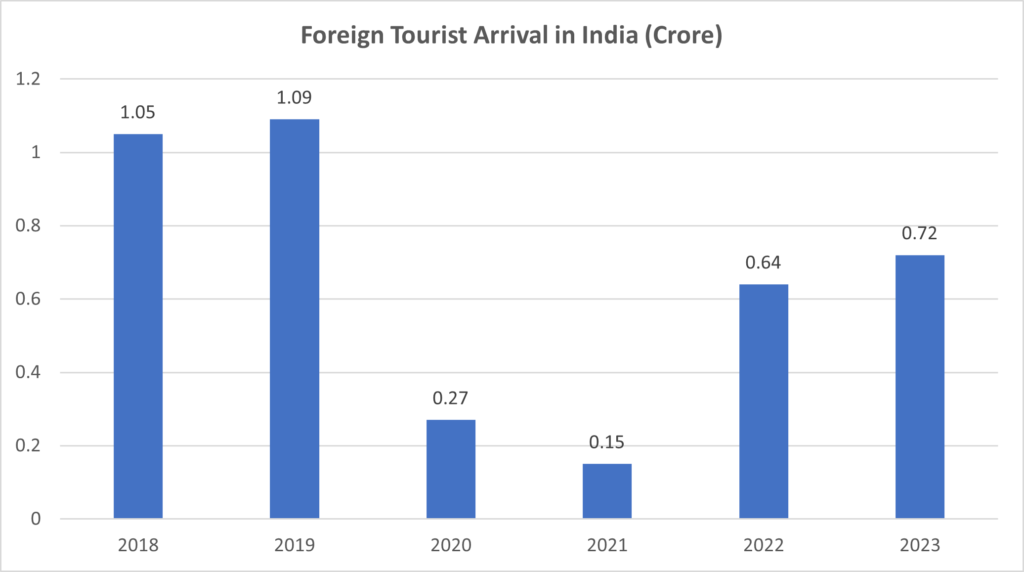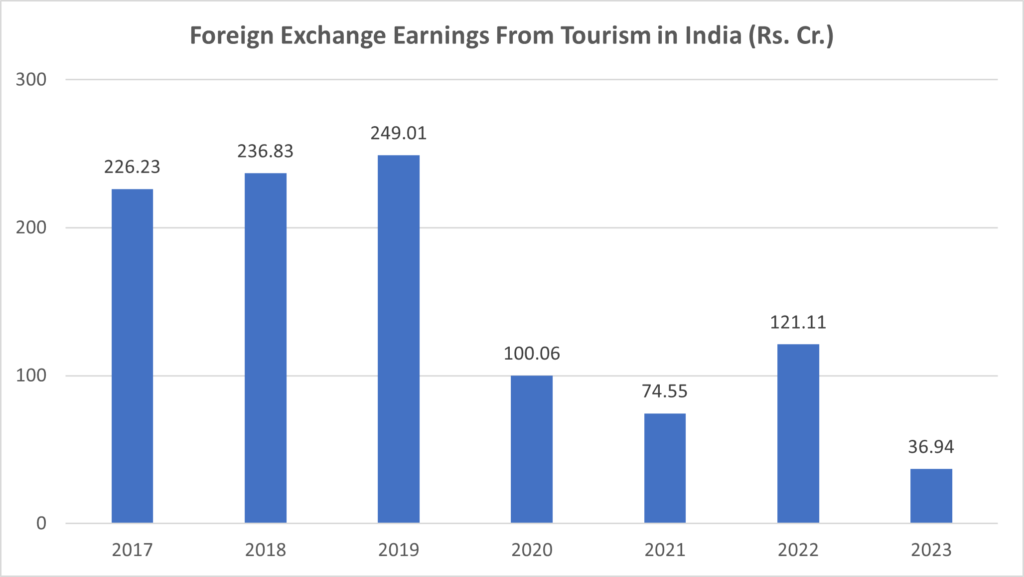India is a land of diversity. It is a blend of multicultural society and ethnic groups. It is one of the oldest civilizations in the world. It is known for its extensive attractions and rich heritage and is one of the most well-visited tourist destinations globally. Travel and tourism are one of the largest service industries in India. The main objective of this sector is to develop and promote tourism by maintaining the competitiveness of India as a destination for tourism as well as by improving and expanding the existing tourism products to ensure the employment generation and economic growth of the country.
India’s tourism industry has grown significantly due to its rich culture and diversified ecology. India’s tourism sector ranks eighth in Gross Domestic Product (GDP) contribution. The sector was also one of the largest foreign exchange earners (FEEs). As per the Ministry of Tourism, Foreign Tourist Arrivals (FTAs) in March 2023 were 7,95,827 as compared to 3,42,308 in March 2022 with a positive growth rate of 132.5%.
As the largest industry in the world, tourism creates jobs, and wealth, and opens the minds of individuals to different lifestyles. The tourism sector is essential to the process of transforming various developing nations into employment-producing regions with a growing labor force. It is one of the significant businesses that has benefited from foreign trade and demonstrated significant development potential under the liberalized Indian economy.
Government Support to Promote Tourism:
- The Indian Government has inaugurated 9 tourism development projects in 6 states and union territories and has launched 43 tourism development projects in 21 states and union territories.
- These projects provide benefits such as:
- Enhanced spiritual tourism experience for the pilgrims.
- Strengthening of safety and security of pilgrims and tourists.
- Generation of employment and entrepreneurship opportunities for tourist guides, souvenir shop owners, handicraft artisans, taxi drivers, and other local businesses.
- Enhancing the ease of living of the local community at the destinations.
- Skill development of the local youth
- Preservation of local cultural and natural resources.
- Launch of “Chalo India” Global Diaspora Campaign to enable Indian diaspora to become Incredible India Ambassadors.
- Launch of “Dekho Apna Desh People’s Choice 2024” a tourist destination poll to identify the most preferred tourist attractions in India.
- Unveiling of 42 destinations selected under the Challenge-based Destination Development Scheme.
- In the Interim Budget 2024-25, Union Finance Minister Smt. Nirmala Sitharaman proposed Rs. 2,449.62 crores for tourism development around the key religious sites in the country. The budget has increased from Rs. 2,400 crores in 2023-24. There is a huge scope of opportunities for jobs and entrepreneurship for the youth and to take the promotion of tourism on mission mode, with the active participation of states, the convergence of government programs and public-private partnerships.
- Under the Interim Budget 2024-25, an outlay of Rs. 1,750 crores have been allocated for the Swadesh Darshan Scheme up from Rs. 1,412 crores in 2023-24.
- A framework to rate spiritual tourism centers will be developed on the basis of the facilities, services, and quality provided to the tourists.
- The states are encouraged to develop their ‘iconic centers’ and brand and market them globally. Interest-free loans will be provided to them for this purpose.
- The budget for overseas promotion has been reduced drastically from Rs. 167 crores to Rs. 3 crores for FY 2024-25.
- “To address the emerging fervour for domestic tourism, projects for port connectivity, tourism infrastructure, and amenities will be undertaken on our islands, including Lakshadweep. This will also generate employment,” said the finance minister.
- For FY2024-25, the Government has allocated Rs. 240 crores for the “Pilgrimage Rejuvenation and Spiritual Heritage Augmentation Drive” (PRASHAD) scheme, launched in 2014-15 to promote religious tourism in India.
- 50 tourist destinations will be selected through challenge mode to be developed as a whole package for domestic and international tourism.
- Sector-specific skilling and entrepreneurship development to be dovetailed to achieve the objectives of the ‘Dekho Apna Desh’ initiative.
- Tourism infrastructure and amenities to be facilitated in border villages through the Vibrant Villages Programme.
- Unity Malls to be set up in State Capitals or prominent tourist centers.
The developmental initiative by the Government in the Indian Tourism:
The Indian government has taken several actions to establish India as a major international tourism destination after realizing the potential of the nation in this sector. The following are a few of the significant programs the Indian government has in store to strengthen the country’s tourism and hospitality industry:
- An investment-linked deduction under Section 35 AD of the Income Tax Act is in place for establishing new hotels under the 2-star category and above across India, thus permitting a 100% deduction in respect of the whole or any expenditure of capital nature.
- Government of India has set a target to create 220 new airports by 2025.
- A separate liquidity window of Rs. 15,000 crores have been released for the sector.
- FDI inflows in the Tourism & Hospitality sector reached Rs.136.51 crore between April-June 2022.
- The Medical Tourism sector is expected to increase at a CAGR of 21.1% from 2020-2027.
- The Indian government has estimated that India will emerge with a market size of 1.2 million cruise visitors by 2030-31.
- The government of India has introduced the concept of e-tourist and e-medical visas which has helped increase inbound tourists to the country. Additional initiatives such as Atithi Devo Bhava, a 24×7 multi-lingual Tourist Helpline, among others, have helped improve the safety and security of tourists.
- Under this Loan Guarantee Scheme for the affected Tourism Service Sector (LGSCATSS), a loan of up to Rs. 10 lakhs will be extended to each Tour Operators/ Travel Agents/ Tourist Transport Operators approved/recognized by the Ministry of Tourism.
- Guarantees for Skill Development Loans by the member banks of IBA up to Rs. 1.5 lakh extended by lending institutions to eligible borrowers without collateral or third-party guarantee.
- The Ministry of Tourism has partnered with the Quality Council of India (QCI), to assist the Hospitality Industry in their preparedness to continue operations safely and mitigate risks arising out of the COVID-19 pandemic through an initiative called SAATHI (System for Assessment, Awareness, and Training for Hospitality Industry).
- Wellness tourism is promoted by positioning India as a centre of Ayurveda, Yoga, Siddha, Naturopathy, etc. together with the spiritual philosophy that has been integral to the Indian way of life. To support this, a scheme is launched called AYUSH which helps by providing guidelines to establish these wellness centers.
How tourism is a great part of the economic development of the country
In India today, tourism plays a significant role in the economy and makes significant contributions to the nation’s inclusive and sustainable development. India has been successful in becoming the most popular travel destination for both domestic and foreign tourists. Travelers from abroad are introduced to India’s unity in diversity philosophy through tourism. Like in many other developing economies, the tourism industry has played a significant role in generating foreign exchange, opening up job opportunities, and increasing household income for Indians over the years. It has facilitated regional and economic development and provided the chance for infrastructure development. As a result, the growth of the tourism industry was just as significant as the growth of other economic sectors in India.

In 2018 and 2019, India saw 1.05 crore and 1.09 crore foreign tourist arrivals respectively, which dipped to 0.27 crore in 2020 due to the pandemic. These numbers dipped more in 2021 to 0.15 crore. There was a rise in the years 2022 and 2023 to 0.64 crore and 0.72 crore respectively but were still less than the numbers pre-covid.

India received Rs. 226.23 crores in 2017 in Foreign Exchange Earnings. There is a huge difference in the FEE in 2017 and 2021. It stoops down to Rs. 74.55 crores in the year 2021 due to covid which then rose to Rs. 121.11 crores in 2022. From Jan to March 2023, the returns were Rs. 36.94 crores from the Foreign Exchange Earnings (FEE).
What is the future outlook of the Government for Indian Tourism?
The Indian government has implemented several infrastructure initiatives to boost travel nationwide. India’s travel industry is expected to grow to Rs. 1,035.48 crores by 2027, according to the FICCI. One of the main sectors in the nation that creates jobs is the tourism and hospitality sector. There were 798.6 lakh direct and indirect jobs in the tourism industry in FY20. It is anticipated that this trend will continue and assist India in earning foreign currency. Moreover, India is probably going to put a lot of emphasis on the states in its northeast, utilizing the enormous potential of the area’s breathtaking scenery, rich cultural history, and rich heritage.
Roadblocks in attracting tourism in India.
The tour packages for Indian hill stations are expensive which in turn, increases the opportunities for foreign destinations. Indian residents prefer international trips instead of domestic due to the price variations.
Word-of-mouth also plays a major role in shaping travel decisions. Satisfied travelers will likely recommend destinations based on their positive experience. Conversely, dissatisfied tourists may leave unfavorable reviews about the place and its services.
Also Read: How the Ram Janmabhoomi Temple is Transforming Ayodhya: Tourism and Economic Boost
